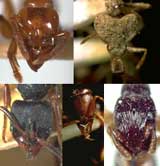Ants make web

Researchers can now crawl through data on 11,000 ant species. <br>© Antbase <br>
Formidable catalogue puts army of ants online.
After four years of cooperation and tenacity worthy of their quarry, ant experts have completed Antbase, a centralized, online information resource cataloguing all 11,000 known species of ant.
Its creators hope that Antbase will one day become the ant equivalent of GenBank, the public database of genetic sequence data, and a boon not just for ant specialists, but for entomologists and ecologists of every kind.
Ant taxonomists Donat Agosti of the American Museum of Natural History in New York and Norman Johnson of Ohio State University in Columbus built Antbase using funds from general research budgets and small institutional grants. Having compiled a full list of ant names, they hope their homespun project will now win long-term funding and a permanent home. “It needs to be institutionalized,” says Agosti.
The database’s backbone is an updated list of species names. Compiling the list was anything but trivial, Agosti and Johnson say. Descriptions of new species published in obscure journals over the past century had led to heavy duplication. As the project progressed, Antbase shrank to its current size from an initial list of over 20,000 names. “We’re trying to pick up the debris from nineteenth-century taxonomy,” says Johnson.
Records for each species are being linked to information on their geographical distribution and life history, plus pictures held by the Japanese Ant Color Image Database.
Antbase could emerge as a long-needed resource for ant taxonomists, says Ted Schultz, who works as one at the Smithsonian Institution in Washington DC. “Before, you had to spend hours photocopying thousands of pages of primary literature,” he says. The resource could also aid more general studies of ecosystems, where ants often have a prominent role. “Ants are an incredibly useful ecological indicator,” Schultz adds.
Media Contact
More Information:
http://research.amnh.org/entomology/social_insects/All latest news from the category: Life Sciences and Chemistry
Articles and reports from the Life Sciences and chemistry area deal with applied and basic research into modern biology, chemistry and human medicine.
Valuable information can be found on a range of life sciences fields including bacteriology, biochemistry, bionics, bioinformatics, biophysics, biotechnology, genetics, geobotany, human biology, marine biology, microbiology, molecular biology, cellular biology, zoology, bioinorganic chemistry, microchemistry and environmental chemistry.
Newest articles

A universal framework for spatial biology
SpatialData is a freely accessible tool to unify and integrate data from different omics technologies accounting for spatial information, which can provide holistic insights into health and disease. Biological processes…

How complex biological processes arise
A $20 million grant from the U.S. National Science Foundation (NSF) will support the establishment and operation of the National Synthesis Center for Emergence in the Molecular and Cellular Sciences (NCEMS) at…

Airborne single-photon lidar system achieves high-resolution 3D imaging
Compact, low-power system opens doors for photon-efficient drone and satellite-based environmental monitoring and mapping. Researchers have developed a compact and lightweight single-photon airborne lidar system that can acquire high-resolution 3D…





















